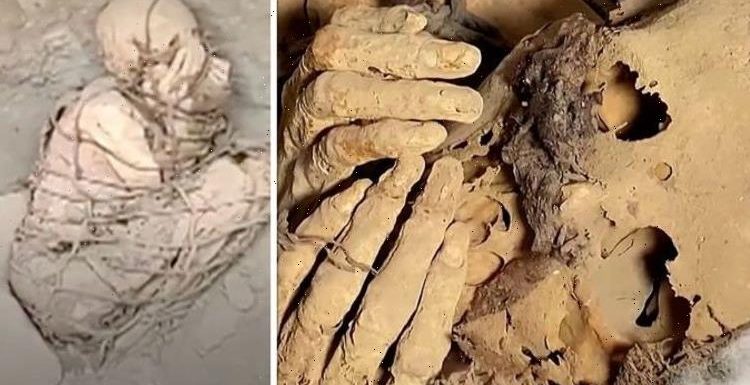
Archaeologists discover drilled holes in mummified body in 2020
We use your sign-up to provide content in ways you’ve consented to and to improve our understanding of you. This may include adverts from us and 3rd parties based on our understanding. You can unsubscribe at any time. More info
The remains are reported to be from a culture between the mountains and the coast of the South American country. The gender of the person has not been identified but the body is said to date to before the founding of the Inca Empire in the fifteenth century. Archaeologists think it is between 800 and 1,200 years old. The mummy was found east of Lima, Peru’s capital, archaeologist Pieter Van Dalen Luna announced this week.
The expert from the state university of San Marcos said: “The main characteristic of the mummy is that the whole body was tied up by ropes and with the hands covering the face, which would be part of the local funeral pattern.
“Radiocarbon dating will give a more precise chronology.”
Archaeologists said the mummy is likely to be from Peru’s mountainous Andean region.
JUST IN: Russia outsmarted as UK handed way out of Putin’s energy crisis: ‘Can skip dependency’


The remains were unearthed from an underground tomb along with offerings including ceramic pots, vegetable remains and stone tools.
Peru has hundreds of archaeological sites from cultures that were around before and after the Inca Empire.
The tomb where the mummy was found is located in the wider Cajamarquilla archaeological site.

The area was first settled by the Huari civilisation, which developed along Peru’s coast from around 400 to 600 AD.
Remains of mud-brick houses and pyramids make up what was once one of the country’s largest cities.
The ancient site is thought to have later been taken over by the Inca, who dominated most of the Andean region by the time of the Spanish conquest in 1532.
DON’T MISS:
Peru earthquake: Powerful 7.5 magnitude quake rocks Ring of Fire [LATEST]
Brexit chaos as Britons breaking 90-day Schengen rule ‘given 24 hours’ to return to UK [INSIGHT]
WW2 British spy saved up to 200 Jews a day from Nazi persecution: ‘Saved a generation’ [ANALYSIS]

Cajamarquilla has been recognised by Peru’s Instituto Nacional de Cultura, however, the area is under threat.
Urban sprawl on the fringes of Cajamarquilla has encroached on the site, while it has also been used as a dump and as grazing land.
Up to 25 percent of the site has already been lost, with more of the site being destroyed annually, according to the World Monuments Fund.
Source: Read Full Article